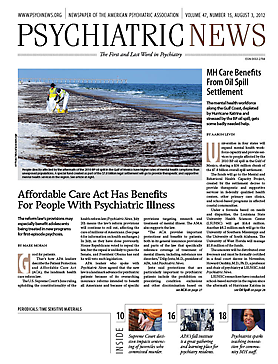Comparing the mental health effects of the wars in Iraq and Afghanistan on British and American troops should be easy.
Both armies fought the same war, over the same territory, against the same enemy, at the same time, with similar percentages of casualties, said Simon Wessely, M.D., a professor of psychological medicine and vice dean at the Institute of Psychiatry, King’s College London. He spoke at the annual Department of Defense/Veterans Affairs Suicide Prevention Conference in Washington, D.C., in June.
Both nations’ troops also faced similar stigma and access concerns regarding mental health problems. Like their American counterparts, British troops were reluctant to disclose symptoms before deployment for fear they would be left behind by their units. They were equally reluctant to disclose on the way home for fear that homecoming would be delayed pending treatment.
Yet the differences are also instructive, said Wessely.
Rates of posttraumatic stress disorder (PTSD) found among British troops are lower than those in U.S. troops, but are higher among reservists than regular active-duty military. In both armies, combat exposure is the primary risk factor.
“The real problem in our armed forces is alcohol misuse, which causes much more harm in the service than any other mental health issue,” he said. There is less alcohol abuse among reservists than regular troops.
Wessely suggested several possible explanations for differences in PTSD rates. When the wars began, troops in the British forces were on average older (27) than their U.S. counterparts. They had proportionately more officers and used fewer reservists (10 percent vs. 30 percent). Many had experienced prior deployments in other parts of the world.
“But the key difference, in my opinion, is the time in theater,” he said. British troops served for six months at a time in Iraq and Afghanistan then were home for 18 months. U.S. Army soldiers served for 12 to 15 months at a stretch, then were home for just a year. (U.S. Marines served shorter deployments.)
“Tour length must be a factor in these different rates of mental health outcomes,” he said.
Suicide rates were another point of difference.
Suicide in the British armed forces remains lower than in the general population. That was once also true in the United States, but the rate among American soldiers has risen to the civilian level in recent years. Meanwhile, overall suicide rates in Britain have declined in the last decade, especially among young men and discharged psychiatric patients, although the reasons aren’t clear.
Suicide rates in the British forces have risen only among the youngest army recruits, those aged 16 to 19 who fail to complete their first four-year enlistments, said Wessely.
That cohort faced other problems besides suicide—alcohol, drugs, poor mental health, unemployment, trouble with the law, or debt. They were likely unready for military service or were subjected to bullying once in, he suggested.
He noted that to an even greater extent than in the United States, returning British troops are portrayed in the popular media as irreparably damaged by war—likely to end up homeless, unemployed, or in prison or mental hospitals.
The difference in suicide rates may be due to differences in culture and health care systems in the two societies, he said.
Wars inevitably change the people who fight them, but change should not be equated with illness, he said. “We have to be careful that we don’t mix up the fact that when you come back from war, everyone is different, in all sorts of ways, but only some have the mental health problems that we are here to treat,” said Wessely, ending his talk with a personal anecdote about his father, who survived the sinking of two Royal Navy ships in World War II. “He still has nightmares about it at age 87, but he does not have a mental illness,” said Wessely.
“There is a danger on both sides of the Atlantic that we’re occasionally overmedicalizing those who are simply different people who have been to and come back from war. We have to have an adult conversation about ensuring that we’re treating those who need treatment and not those who don’t.”

